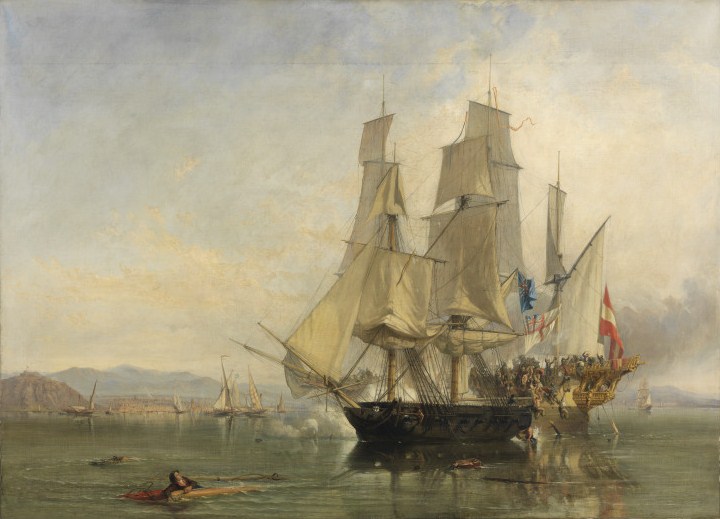Master and Commander – Patrick O’Brian (1969)
by Chingiz Ismailov
Data and Geordie; Frodo Baggins and Samwise Gamgee; Crockett and Tubbs; Bill and Ted; Holmes and Watson: I could go on. These are some of the greatest bromances in fiction, friendships that transcend the screen and printed page, reaching an authenticity, a reality we wish we’d see more often in our own all too real lives. A pair of names that belongs at the top of the list is Aubrey – Maturin.
I remember seeing Master and Commander: The Far Side of the World as a child without any sense of the historical context of the Napoleonic Wars, or even the timeline of the golden age of sail. The film premiered several months after the first Pirates of the Carribean (itself a huge critical and commercial success) and audiences and critics were expecting another swashbuckling adventure. What we got was bits and pieces from O’Brian’s Aubrey – Maturin series distilled into a masterpiece criticised (at the time) for lacking action; a gritty peek into the realities of Napoleonic naval warfare. And yes, I enjoyed both films, much as I enjoy both Wile E. Coyote and the Roadrunner cartoons and David Attenborough documentaries. Master and Commander: The Far Side of the World, I feel obliged to mention, was nominated for 10 Oscars, winning 2, but losing out to Lord of the Rings: The Return of the King. Fair enough.
That film was my first encounter with the series of books, and only now, 18 years later, do I get around to reading them. Master and Commander, the first in the series, strikes that perfect balance between historical accuracy – or rather, authenticity – and powerfully addictive storytelling with vividly present characters and relationships. This is something the film also achieved, a film now often referred to as an overlooked masterpiece. The two main characters lending their name to the series are Jack Aubrey, and Stephen Maturin – the former a bullish naval officer who lives to fight on the high seas, drink and womanise on shore, a real man’s man that raises his toast to King and Country; the latter a physician and scientist, thin, pale and introspective, a quintessential man of the Enlightenment, abhorring personal violence in keeping with his oath. He also happens to be an intelligence agent and a member of the United Irishmen, a suppressed group that historically called for representative government in Ireland. Yet, much like Schwarzenegger and Belushi in Red Heat, an initial friction leads to mutual respect and ultimately, friendship.
Through Maturin, unacquainted with even the basics of seamanship, let alone naval combat, we landlubbers learn the jargon (though, at times I still had to look up certain terms: clewline? deadeye?) and basics of life on a Royal Navy sloop-of-war. Even with my ignorance of the nautical terms and real-world historical backdrop (many of the secondary characters were real people; some of Aubrey’s victories and defeats aboard the sloop Sophie were based quite closely, down to the details, on the almost-unbelievable naval exploits of Thomas Cochrane) I could feel the intensity of the battle like a civilian cowering behind the gunwales, watching the action, cringing when a cannon runs over someone’s foot or a poor sailor is shredded by wood splinters, cheering with the crew when the enemy surrenders.
Master and Commander is not just a war novel – though an interest in war at sea enhances the experience: it’s an exploration of the psychology of the two men Aubrey and Maturin, their friendship and their own personal trials, doubts, introspections, and in Aubrey’s case, ambitions. Often when you hear “historically accurate” the mind instinctively recoils at the thought of dry pedantry, but Master and Commander plays history as a strength: we are transported as if in a time-machine aboard the Sophie, asking ourselves how would we fare not only when the cannonballs start flying, but when the crew becomes restless? When the water runs out? When our friend is whipped for disobedience? How would we gain the respect and obedience of a ship full of sailors? When those leading us, whether we’re officers or enlisted, begin to doubt themselves, leading us into a hopeless, even fatal situation?
The whole series is best treated as one long book of 20 parts, an unromatic and gritty, though never humourless, portrayal of naval life during the Napoleonic wars, both at sea and on land, where ingratiating yourself with the big-wigs is just as important as the weather-gage. But what truly makes this and O’Brian’s other novels in the series so great is the rich yet subtle characterisation, not just of Aubrey and Maturin, but those that surround them in the salons, admiralty offices, inns and taverns, as well as on deck.
